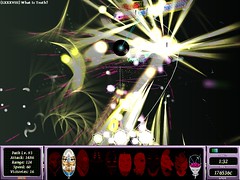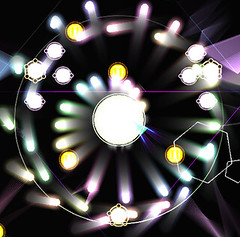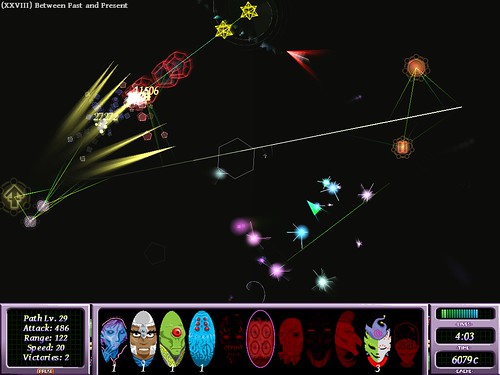Posts from ‘Interviews’ Category
TIGER Sauce Interview: 2d Boy
By: Derek Yu
On: November 26th, 2007
2d Boy are actually two men – Ron Carmel and Kyle Gabler. Together, they’re living the indie dream. You may recognize Kyle as the developer behind the Experimental Gameplay Project and Tower of Goo, the unique physics game that has you building structures out of little goo balls. World of Goo, the company’s first title, takes the basic idea behind Tower of Goo, and expands it into a living, breathing world.
Steve Cook got a chance to throw the dynamic duo a few questions about IGF (in which World of Goo is a competitor), the indie life, and how their goo balls are doing1.
Read the full interview here.
1They’re doing pretty goo… d. Good. Get it? I know, I’m sorry.
Word Play
By: Terry
On: October 19th, 2007
Veteran game reviewer Kieron Gillen (who’s previously written for PC Gamer, EDGE and Eurogamer, among others) has reposted an old EDGE article to his collaborative games blog, Rock Paper Shotgun. The article is entitled “”http://www.rockpapershotgun.com/?p=440">Word Play", and it’s about the use of text in videogames.
The first half of the article is compelling enough, I suppose, but it’s the second part that’s really interesting to me. Kieron moves on to discuss “one corner of the modern games scene [where text] is dominant… the Interactive Fiction or IF Community. Or, as they were known in the eighties, text adventures.”

This section includes interviews with IF notables Emily Short and Adam Cadre (the authors of Galatea and Photopia, respectively), and talks about their influences, their approach to game design, and their view of how things are going to pan out for IF in the future.
I remember reading it in EDGE a few years ago, and at the time, I’d only played Photopia and some older well known text adventures like Zork and Colossal Cave. This article is what finally got me to explore Interactive Fiction in more depth, and I’m quite glad I did! There seemed to be something missing from this republished version though, so I dusted off my collection of old copies of EDGE and had a look for the original article (it’s November 2004, E142). Huzzah! The original had a little separate boxed off section titled “A short IF reading list”, which listed a number of introductory titles that I recommend checking out as soon as you possibly can, if you haven’t already.
I don’t know why this wasn’t included in this version of the article, but it’s well worth reading, so I’ve copied it from the original and reproduced it here. Hit the extended to read it!
A short IF reading list [from EDGE 142, November 2004]
With hundreds of games available, it’s difficult to know where to start with IF. In an attempt to avoid such difficulties, these are a handful of relatively accessible base camps to start your explorations.
PHOTOPIA (ADAM CADRE)
A fractured narrative piece that takes its time to unwind, juxtaposing real-world encounters with a dreamy fantasy story. When it hits its emotional target, it takes off the top of your head.
SHADE (ANDREW PLOTKIN)
Kitchen-sink realism transforms into unresolved, lingering and disturbing psychodrama. Also consider the longer, puzzle-based Spider and Web, based around flashbacks from an interrogation.
GALATEA (EMILY SHORT)
A conversation between an art critic (the player) and a living statue (the single, highly developed NPC). With dozens of endings, this is unique and literate. Consider also Short’s later, relatively short romances Pytho’s Mask and Best of Three.
SHRAPNEL (ADAM CADRE)
More of a fragment, in every definition of the word, than a fully developed piece, this is still a memorable and brutally powerful work.
RAMESES (STEPHEN BOND)
Minimal in terms of player action, this uses forced inaction as a metaphor for teenage depression.
All games are available from the IF Archive. Links and reviews are available from Baf’s IF Guide. Most games will require a Z-Code interpreter to play, also available from the above. We recommend WinFrotz for Windows, but MacOS, Linux and PocketPC versions, among others, are also available.
Interview: Petri Purho
By: Derek Yu
On: September 27th, 2007
Jarkko Laine has put up a short-but-sweet interview with Kloonigames’ Petri Purho. Petri is the developer behind numerous great indie games, including Crayon Physics and A Tribute to the Rolling Boulder.
Recently he contributed the hilarious SM Word to the TIGSource B-Games Competition.
(Source: GameSetWatch)
MTV Interview: Jonathan Blow
By: Derek Yu
On: August 9th, 2007
MTV’s all up in indie gaming’s grill these days, and with good reason. This time they’re doing an interview with the one-and-only Jonathan Blow, about life, games, and Braid.
I’m noticing that Jon is getting a little bit of flak for his interview, most notably in the comments of Wired’s Game|Life blog. Now, I know he doesn’t need me to defend him, because he is an extremely smart and successful guy who could also kill any one of us with kung fu (really), but seriously, as someone who has heard Jon speak and played his game (albeit an early version), let me just assure you that a) if you perceive any egotism or condescension on his part, it’s the inevitable result of his being brilliant and also honest (he’s actually quite down to earth), and b) he is fully deserving of the so-called “hype” he’s been getting. Honestly, he deserves more. And a lot of independent developers do.
And c) it’s really sad how you can’t criticize anything anymore without somebody taking immediate offense and calling you a “wanker.” I give more credit to the man who is called a wanker because he has lots of strong opinions than the man who’s only opinion is that someone else is a wanker. Alright, you wankers?
Siliconera Interview: Kenta Cho
By: Derek Yu
On: July 24th, 2007
There’s a short interview with Kenta Cho up on Siliconera where he talks about Blast Works and console development. Some choice quotes:
I’m a bit saddened that it seems Kenta Cho is not involved more in the development of this port. The fact that he seems unaware that Blast Works is now going to include, at the very least, rRootage, but possibly also Gunroar and Torus Trooper, makes me uneasy. Not sure why Siliconera didn’t ask him about this.
The guy seems incredibly easy going and happy to see his games on consoles. But if there were ever a time when I’d like to see someone’s name in front of a game title, it’s now.
Weekend Videos
By: Derek Yu
On: July 13th, 2007
Everyday Shooter, official E3 trailer:
Jon Mak on Everyday Shooter, artistry as a game developer, and “innovation:”
Hahaha… I love Jon! The interviewer might as well have been a cement brick. Gotta stay until the end, it’s awesome.
De Blob gameplay video:
It looks fun, although I wish there was more interaction with things other than buildings. I also second that the original blob character design was better. But then again, you have to remember that they’re marketing for people like this:
That’s it! Have a great weekend, folks!
(Sources: Indygamer)
Everyday Shooter Heading to PS3
By: Derek Yu
On: July 11th, 2007
Other indie news sites broke this story first. But none of them broke it with this sexy pic of Jonathan Mak.
N’Gai Croal’s “Level Up” blog is increasingly becoming a place for juicy exclusives. This time N’Gai (awesome name) reveals that Jon’s sensational musical shoot ‘em up, Everyday Shooter, is hitting the PS3 to join Jenova Chen’s fl0w. There’s also an interview with Jon before he headed to E3 (now one day in and counting):
The best part is that I can totally hear his voice the whole time I’m reading the interview.
No word yet on the fate of the PC version of the game.
thatgamecompany’s Kellee Santiago
By: Derek Yu
On: July 8th, 2007
It’s a funny thing… on Friday I was having a conversation with Alec about female game developers where neither of us could name a single female indie developer, and then today I read this interview with Kellee Santiago, president of thatgamecompany.
The interview, sadly, doesn’t reveal too much about what TGC is working on, only that they’re signed into a 3-game deal with Sony and that their next project will explore “an emotion that’s different from mainstream games.” I wonder which emotion that is? I know it’s definitely not Schadenfreude…
But yeah, more girls making games!
EDIT: DMac just schooled my ass by listing a bunch of female indie game developers, many of which I had heard of. So I’m a chauvinist pig and he’s a stalker. Apparently.
Gamekult Interview: Nifflas
By: Derek Yu
On: June 22nd, 2007
“”http://en.wikipedia.org/wiki/Ico">Ico [has] affected everything about what I value in games: atmosphere over gameplay and power-ups, items, bosses… Ico is not about what the game is, it’s about what the game is not – despite the very little music, very small amount of possible moves, bonus games, etc. It’s so incredibly beautiful in every way. So I’d say it have had a huge impact of all my future game designing.
Knytt is built on the same philosophy, and I had to create the Ljus level in Within a Deep Forest (the only level without music) after playing Ico (I was near the end of the WaDF development when I played that game for the first time). But even before I had played Ico, I value atmosphere a whole lot.“ -from the ”http://www.gamekult.com/blog/darknemo/59123/Portrait+Nicklas+Nygren+Ume%E5+Suede.html">interview
I didn’t realize Nifflas was Jesus. But I had a hunch.
(Source: Timmy)
TIGS loves the coc- Immortals!
By: Lorne Whiting
On: June 20th, 2007
Interview with Rinkuhero of Immortal Defense fame, about Immortal Defense.
I’m kind of interested in who John Thornton is… perhaps, he and Rinku are mating partners!
1: The story is known as one of the best parts of Immortal Defense,
where’dja get your inspiration for it and why did you put a story in a
Tower Defense game?
The story was actually written by John Thornton, not me — we did
outline it together though. I decided to put a story in a tower
defense game because games without a story seem hollow and pointless
to me. I’m not saying the story is the most important aspect of a
game, just that when it’s absent or lacking, it brings down the rest
of the game.
When I play a normal tower defense game I’m thinking: What am I
defending? What are these things that I’m killing thousands upon
thousands of? Why am I doing it? What’s the point? Why aren’t they
fighting back, and just marching along like lemmings? Where are they
coming from, why are they doing this? The story in Immortal Defense
provides answers to those types of questions, so it doesn’t leave a
player wondering why they are doing what they are doing.
2: Did you intend to make me feel like a really bad person with the
story of chapter 5?
Again, you’re better off asking the writer of the story. I just asked
him, and he replied “Hahaha, yes.” If a person briefly felt that they
were a bad person for killing things all day, even though they
realized it was necessary, that’s a bonus. I think violence in games
can be fun, but I don’t think that violence is accurately portrayed in
games. It’s accurate in terms of the methods of violence and
sometimes even what violence looks like, but most games are inaccurate
in terms of the results of violence. I’d like to see more games about
the other aspects of violence.
3: The game seems, at least to those of us that did not know of you
before, to have come out of nowhere. How much time did you spend
making it?
We spent just under six months on it. I don’t think it came out of
nowhere though; a preview was posted on Indygamer
(one of the largest independent game blogs) about halfway through its
development. Six months is a record for me, most of my games take far
longer (except for contest games that I intentionally made in 2 days).
4: What are your favorite points in the game or strategies? Personally, my favorite is a level 7 fear with a level 7 ortho nearby.
My favorite Point in the game is the Love Point, but that’s solely
because of the secret ending to the game (in Hellspace). Strategy-wise
my favorite is the Strategist Point, especially at level 7, but I
think they all work together and have their uses, none is underpowered
over overpowered as far as I can see (people have said that, but it
hasn’t been consistent, there’s no one Point that people universally
feel is the best or the worst). But the Fear + Ortho combination you
mention is really great, and works in most situations.
5: Where’d the designs for the points come from? Seems kind of odd, how we have a bunch of emotion based ones, ala Fear, Love, or Courage, then we have things like Lovecraftian squid beasts called Cut points or the all powerful brain in a jar Danmaku.
They came out of wanting to make each dissimilar to any tower type in
any tower defense game, and distinct from each other. Cut is symbolic
of decision-making (note the similarity between the words decision and
incision), and Danmaku is symbolic of universal understanding, so I do
think all the Points are aspects of the mind.
Roughly, their progression represents the progression of feelings we
have when we are defending something: first we Fear what will happen
to that which we defend, then we gain Courage, we think about what to
do (Ortho), we decide to take action (Cut), and so on, and finally, at
the end, we change our mind (Turning) and then gain understanding
(Danmaku).
6: Were there any problems during development? Any show-stopping things that made you want to give up?
Yes and no. There were problems, there are going to be problems with
any game that anyone makes. At one point there were random crashes
that hard-crashed most of the computers in the world, except the
ones I had access to, which was difficult to fix (though I finally did
after a few weeks). There were also endless arguments within the team
about my bizarre tastes (for instance, rejecting music or art which
seemed great to the musician and artist but didn’t sit well with me).
That’s probably the hardest part of being a director of a game, having
to tell someone that something they worked on all day doesn’t work and
they have to redo it. But no, I never felt like giving up.
7: The game seems very abstract. Almost black background, random lines
flying every which way, people speaking… The way they do. Was this
all a conscious decision or was it more like “yeah, man, lets have some
fuck’n LINES protruding out of this part”?
Yes. It’s intentionally that way. If you look at the other games on
our site, you’ll see that we are
capable of some pretty good pixel art too, so it’s not just that we
were lazy, it’s that I felt that a game like this required the visual
style it had. I spent over three weeks just on the “weather effects”,
those little floating things that fly around and look weird (you can
see a variety of them on the title screen), trying to get them right.
If you notice, there’s some tie-in between those effects and the
storyline; for instance, there are some protruding lines in a level
called Sunlight, which point from all parts of the level to the corner
of the level, and when you place down a Point, they instead point at
that Point. The effects will go unnoticed by most people, but I think
it has a subconscious effect.
8: I heard you’re in favor of clinical immortality. That must be
interesting. What do you think society (I guess your local society, if
you think it’s relative) would need before they would accept
immortality on a whole?
Well, think about it this way: a hundred years ago the average age that people lived to was about 30. Now it’s about 70. We more than doubled our lifespans in a very short amount of time, and nobody really had any problem accepting it, I’m not even sure most people think about how amazing it is that the average human lifespan doubled over the last hundred years. I think that if it were to double again or even increase by ten, the same thing will be true, people will just accept it and not even notice it.
It’s not going to come all at once, you won’t wake up and hear on the
news “Okay, you don’t have to die anymore,” it’s going to be far more
gradual, people will live to 100 on average, then 200 on average, then
1000 on average. And people will always be able to be killed by
accidents or murder, clinical immortality doesn’t mean you can’t die,
it just means you won’t get old. But this is best explained by people
actually in the field, I recommend this video for those who are interested.
9: What’s it like being (cough cough) rich and famous, now?
Well, my share of the game’s earnings is only about $800 after three
weeks, so it’s still less than having a minimum wage job. And that’s
assuming it keeps up, which it may not (or it may go up, who knows).
But it’s pretty high as far as indie games go, and selling better than
I thought it would.
As for fame, I’ll have to say I’m used to people paying attention to
me either positively or negatively online: I was one of the more
famous people in the Ohrrpgce community (a game creation program), due
to running a magazine for it, there’s actually an entire LiveJournal
community devoted to making fun of me that has existed for years,
there’s a page on Portal of Evil for a likewise purpose. A good-sized
messageboard has been known to use my name as a curse word — I am not
kidding. Compared to those, a little more attention among a few
independent game developers isn’t too hard to handle.
10: Last but not least, when’s the release date?
The release date of Immortal Defense? It was June 1, 2007. Or do you
mean the release date of my next game? We don’t know yet,
optimistically it’ll be early 2008.












